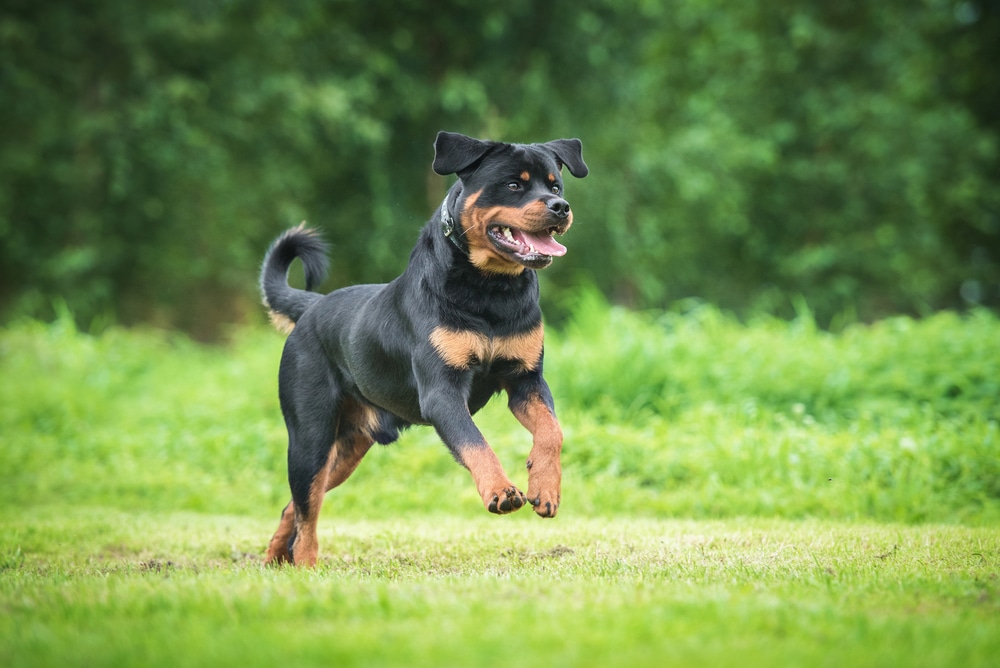Rottweilers are a popular breed of dog known for their loyalty and affectionate nature. However, their size and reputation as guard dogs may lead some potential owners to question whether Rottweilers are suitable for apartment living.
While it is true that rottweilers require daily exercise and training, they can adapt to living in smaller spaces with the proper care and attention.
In this article, we will examine the pros and cons of apartment living for rottweilers. We will also provide tips for training and caring for them in a smaller living space, as well as discuss the importance of exercise and socialization for their health and happiness.
Whether you are a first-time rottweiler owner or considering adding one of these loyal guard dogs to your family, this article will provide valuable information on how to make apartment living with a Rottie a success.
From puppyhood to adulthood, rottweilers are one of the most beloved dog breeds and can thrive in smaller living spaces with the right training and exercise routine.
Key Takeaways
- Rottweilers can adapt to apartment living but require daily exercise, socialization, and mental stimulation.
- Indoor potty training is important for puppies, and weight management is crucial for all rottweilers in apartments.
- Lack of exercise and socialization can lead to destructive behavior and health problems.
- Proper training, preparation, and a set schedule are necessary for rottweilers to thrive in an apartment environment.
Suitability for Apartments
The suitability of rottweilers, or Rotties, for apartment living, is dependent on several factors. One of the most important is their daily exercise requirements, even as a small puppy.
While adult rotties are generally low energy and prefer to lounge around indoors, they still need daily walks and outdoor playtime to maintain their physical health and keep them mentally stimulated. Proper training is also crucial for rottie owners living in apartments.
Puppies, on the other hand, require even more attention and exercise than adult dogs and may not be suitable for apartment living until they are fully grown.
Another important consideration is rottweiler temperament. These dogs are social animals and need regular interaction with other dogs and people to remain happy and well-adjusted.
Apartment living can make it more difficult to socialize rottweilers, as there may be limited opportunities for them to interact with other dogs.
Additionally, the size of the apartment itself should be taken into account, as a small space may not be suitable for a large dog like a Rottweiler.
Ultimately, with proper care and attention, rottweilers can thrive in apartment living, but it is important to carefully consider their needs and potential challenges before making the decision to bring one into an apartment.
Cons of Apartment Living
One potential challenge of keeping a large and active dog breed like the Rottie in a confined space such as a house or apartment is the need for frequent outdoor bathroom breaks and exercise.
Rottweilers, like other breeds, require regular trips outside to relieve themselves, which can be difficult for apartment dwellers without access to nearby open spaces or parks.
Additionally, rottweilers are known for their high energy levels and require daily exercise to maintain their physical and mental health. Without proper exercise, they may become restless and engage in destructive behaviors like chewing or digging.
Apart from bathroom breaks and exercise, socialization is another potential challenge for rottweilers living in apartments.
“Rottweilers, like other dogs, require regular socialization with other dogs and people to develop good behavior and prevent aggression.”
However, apartment living can limit opportunities for socialization, particularly if the owner works long hours or the building has strict pet policies.
As a result, rottweilers – also known as Rotties – may become bored and restless when kept inside a house or apartment, leading to destructive behaviors.
However, with proper exercise, mental stimulation, and socialization, they can make good apartment dogs and be happy and healthy while living indoors with their owners.
It is essential for owners to provide their Rotties with regular exercise and mental stimulation to ensure a happy and healthy living environment for both pet and owner.
Needs of Puppies
Puppies of the rottweiler breed require more attention and physical exercise than adult dogs to maintain their health and prevent destructive behavior. As young and growing dogs, puppies need to be trained and socialized to avoid behavioral issues that may arise in the future.
Here are some specific needs of rottweiler puppies:
- Socialization: Puppies need to be exposed to various people and other dogs to develop their social skills. This can be done through puppy playdates, visits to dog parks, and obedience classes.
- Indoor potty training: Since apartments may not have outdoor spaces easily accessible, it is important to train puppies to use puppy pads or a designated indoor area for potty breaks.
- Exercise: Puppies need daily exercise to prevent boredom and destructive behavior. This can be achieved through short walks, indoor playtime, and interactive toys.
Overall, it is important to provide rottweiler puppies living inside an apartment with adequate attention, exercise, and training to ensure their physical and mental well-being. It is also crucial to establish a designated bathroom area for the dog to maintain cleanliness and hygiene.
Needs of Adult Rottweilers
Adult rottweilers, or Rotties, have lower energy levels compared to their younger counterparts, making them suitable apartment dogs. However, they still require consistent exercise and socialization inside throughout the day to maintain their physical and mental health.
While apartment dogs like rottweiler puppies may be content sitting indoors for extended periods, it is important to engage them in activities that can stimulate their minds throughout the day.
This can include playing games with them in the bathroom, practicing obedience training, and providing them with interactive toys that can keep them mentally engaged.
In addition to physical exercise, indoor activities that can provide mental stimulation for apartment dogs like the Rottie include scent training, puzzle games, and hide and seek.
These activities not only keep them mentally stimulated but can also help prevent destructive behavior that can arise from boredom. It’s important to note that even though they are apartment dogs, Rotties still need to be taken outside for bathroom breaks and exercise throughout the day.
It is also important to provide designated areas within the apartment where the dog can rest and relax. By consistently providing exercise, mental stimulation, and designated relaxation areas, adult rottweilers can thrive in an apartment setting.
Training for Apartment Living
To successfully train a dog, especially a rottweiler, for an apartment environment, it is crucial to establish a consistent routine that includes exercise, mental stimulation, and designated rest areas.
Indoor activities such as puzzle toys and obedience training can provide mental stimulation and prevent boredom. Additionally, potty training can be accomplished by designating a specific area for the dog to use and rewarding them for using it consistently.
It is also important to gradually acclimate the rottweiler to apartment noises and unfamiliar people and animals. This can be done by slowly introducing them to new experiences and rewarding positive behavior.
Creating a designated rest area, such as a crate or bed, can also provide a sense of security for the dog. Proper training and preparation can help rottweilers thrive in an apartment environment, allowing them to be happy and well-behaved companions.
Keeping in mind, that teaching your dog new behaviors can happen quickly and easily by utilizing some clever online training options.
The training listed below is what we highly recommend for quick and lasting results!

Exercise and Health

To ensure that rottweilers can thrive in apartment living, proper exercise and health management are crucial.
While adult rottweilers are generally low-energy and comfortable sitting indoors, they still require daily physical activity to maintain their health and prevent boredom.
Lack of exercise can lead to destructive behavior and health problems such as obesity, which can have serious consequences for a dog’s overall well-being.
Indoor activities can help provide rottweilers with the exercise they need, especially during inclement weather or when outdoor activities are not possible. Activities such as playing fetch, tug-of-war, and obedience training can help keep rottweilers mentally and physically stimulated.
Additionally, weight management is vital for rottweilers in apartments, as they may not have access to large outdoor spaces for exercise. Proper diet and portion control, along with regular exercise, can help prevent weight gain and keep rottweilers healthy and happy in their apartment homes.
Practical Tips for Apartment Living
Proper exercise and health management are essential for ensuring that rottweilers can thrive in a city environment.
Rottweilers are known for their high energy levels and require daily walks and outdoor playtime to maintain their physical health and happiness.
As they grow older, they become less active and may prefer to sit around indoors, but it’s crucial to maintain their exercise routine to prevent destructive behavior and health problems.
In addition to exercise, behavior management is also important for rottweilers living in apartments. Socialization and time around other dogs and people can help them adjust to their new environment and prevent aggression or anxiety.
Training them for apartment living requires preparation, designated areas, adjustment to noises, and a set schedule.
It’s also important to provide them with appropriate chew toys and mental stimulation to prevent boredom. By following these guidelines and working with a pet care professional, rottweilers can live happily in apartments and be great companions for their owners.
Frequently Asked Questions
Are there any specific breeds that are better suited for apartment living than rottweilers?
Alternative breeds for apartment living may include smaller breeds, such as Chihuahuas or Shih Tzus, as they require less exercise and have a lower energy level. Rottweilers may not be ideal for small living spaces due to their size and need for daily exercise.
Can rottweilers be left alone in an apartment for long periods of time?
Rottweilers should not be left alone in an apartment for long periods of time. Training techniques and exercise routines can help manage their energy levels and prevent destructive behavior. Owners should make necessary arrangements for their care.
Is it possible to train a rottweiler not to bark excessively in an apartment setting?
Training techniques such as positive reinforcement and desensitization can help reduce excessive barking in rottweilers living in apartments. Noise complaints can be minimized by providing mental stimulation, exercise, and proper socialization to avoid anxiety and boredom.
How can apartment dwellers ensure their rottweilers get enough socialization with other dogs and people?
To ensure rottweilers in urban environments get enough socialization, owners can find dog-friendly activities in their apartment complex or nearby parks, enroll in obedience classes, and schedule playdates with other dogs. These tips promote healthy social behavior and a happy pet.
Are there any specific health concerns that rottweiler owners should be aware of when living in an apartment?
Rottweiler owners living in apartments should be aware of the potential health issues that can arise due to limited exercise options and indoor activities. Obesity, joint problems, and behavioral issues can be prevented with proper exercise and outdoor playtime.


